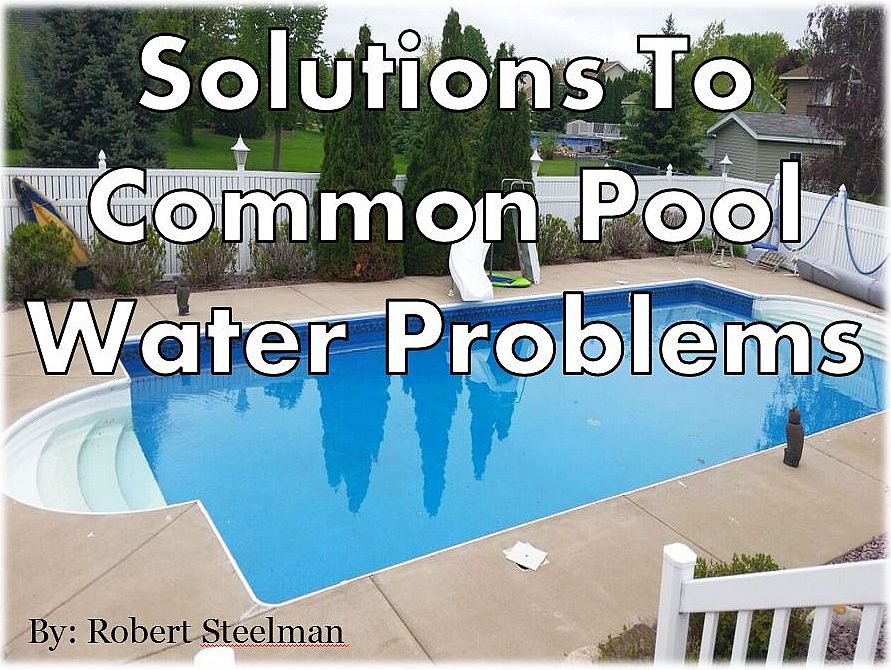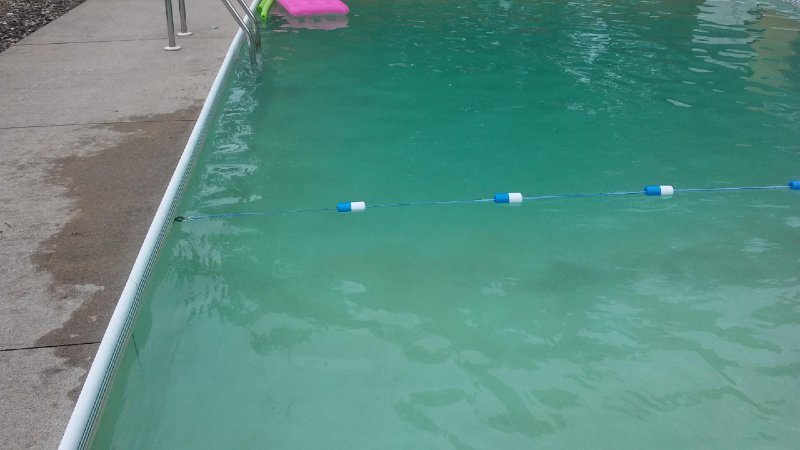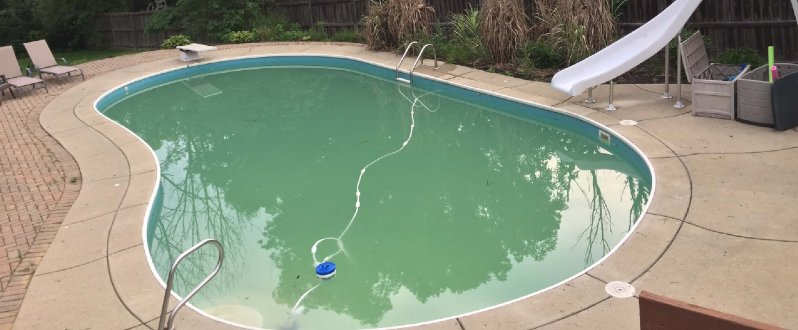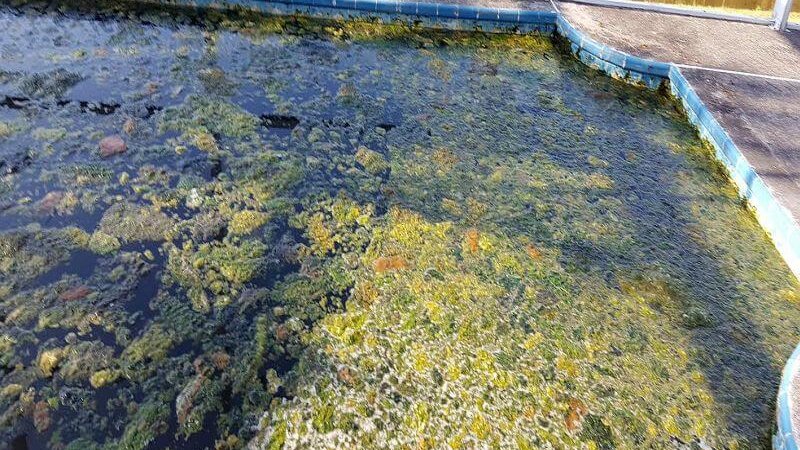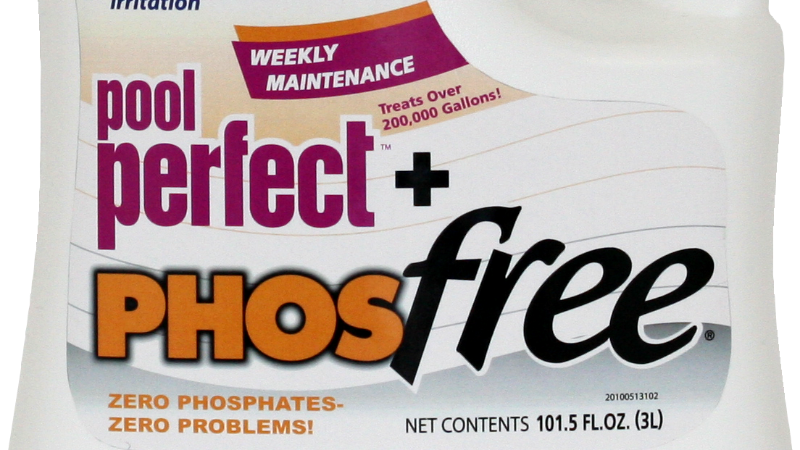- Home
- Troubleshooting
- Black Algae Pool
14 Tips To Kill Black Algae In Your Pool
Pool algae is the bane of every pool owner's life, but black algae will seemingly take on a life of its own. This kind of algae can give you a real headache if not taken care of immediately. Unlike other forms of pool algae that contain chlorophyll, this little guy forms layers and each layer forms a scab. It also has these tentacle like roots that dig into your plaster. Even when you have good pool water chemistry and practice excellent swimming pool care to a "T", it still might not be enough.
You need to get right on this because this bugger, if left on its own, can eat a hole right through your concrete. It's rare in vinyl and fiberglass pools. It can happen, but concrete and plaster pools are particularly vulnerable due to their porous nature.
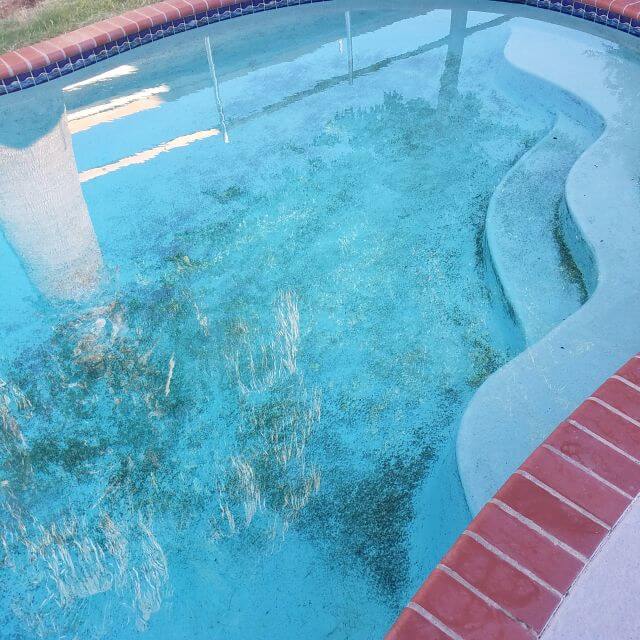 Black Algae On Steps & Bottom
Black Algae On Steps & BottomHow Do You Get Black Algae In Your Pool?
You can get black algae through a variety of sources, but it's mainly introduced into your pool through sources such as unwashed bathing suits or inner tubes that you may have used in the ocean or the river. You did remember to wash those things before you put them in your pool, right? One less common way of getting algae in your pool is through the air.
So for now, let's examine what exactly black algae is. Once we know that, it'll be much easier to get rid of it.
What Is Black Algae?
Black algae is not actually algae, it's a bacteria that's specifically called cyanobacteria. This is a living organism that can grow and reproduce very quickly. Much like green algae, it can double in size very quickly. But unlike a green pool, black algae can actually cause structural damage to your swimming pool. It has roots that can burrow deep into the plaster, through the gunite, and wrap itself around the rebar. Algae normally loves bodies of water with a high pH level, so it's very important to keep an eye on your pool chemical levels and make the right adjustments when needed.
Is Black Algae Harmful?
Although it can be unsightly and usually shows up at the most inopportune time, and can be harmful to humans. Black algae may cause illness, in and of itself. However, it is important to take the right safety precautions. It's not recommended to swim in a pool that has a black algae problem. You should recognize when your pool has black algae and taken immediate steps to eliminate it.
How To Identify Black Algae In Your Pool
There are a few ways you can recognize if your pool has this and they are:
- Black or dark brown raised spots on the pool surface
- They're not free-floating
- They feel bumpy like scabs
- They don't easily brush off with a nylon brush
- Can be small blotches or very large areas
- Can be scraped off with a plastic putty knife and possibly leaves a stain
How To Kill Black Algae
A green pool is different than mustard algae and should be treated accordingly. But black algae is something different. Being it's a bacteria and not an algae, it takes a little more work. It can be done. So here we go.
1. Clean The Filter
We'll never clean dirty water with a dirty or non-working filter or filtration system, so let's get the filter clean. Backwash your sand or D.E. filter. If you have a cartridge filter, make sure you take it out and clean it well. Never use a power washer on a cartridge filter. That's too much pressure and you're not gaining anything by using it. If your cartridge filter has over 3000 filter hours on it, it's time to replace it.
2. Remove Everything From The Pool
Remove and wash bathing suits, toys, floats, and anything else from the pool. Wash your bathing suits in a washing machine and dry them in your dryer. Wipe down everything you removed with a 50/50 solution of bleach and water. You can use a scrub brush for a more thorough cleaning. Place your pool cleaning equipment (telescopic pole, net, brush) in the pool so that it becomes sanitized.
3. Test And Balance Your Pool Water Chemistry
Bring the pH, alkalinity, and hardness into line. Adjust your pH to 7.0-7.2. Chlorine is more active at a slightly lower pH level. Adjust your alkalinity to 80-120 ppm and hardness to 150-250 ppm. Remember to maintain your CYA level at 30 - 50 ppm. For pool water test kits, I use and recommend the Taylor K-2006 kit.
4. Brush Your Pool With A Wire Brush
This cannot be stressed enough. It has tentacle-like-appendages which drill into the plaster. A wire brush is the only way to remove it so the entire pool must be brushed 2 times per day.
5. Shock Your Pool
Increase and maintain a free chlorine level of at least 20 ppm using liquid pool chlorine or bleach. Another technique that works well is to crush up chlorine tabs and add them to the affected areas. Crushed up tabs won't dissolve as quickly and will stay on the area longer.
6. Scrub Affected Areas With A Chlorine Tablet
Yes, you heard that right. You'll literally be grinding the chlorine tab into affected areas. A good tool for this job is called Algae-Gon-Tablet Holder.
7. Sprinkle It On
Get some calcium hypochlorite and sprinkle a thin even layer on affected areas such as steps, bottom, and love seat. Allow this to sit for 24 hours with the pump motor turned OFF. Another great product is a granular chlorine called Dichlor. This is slow dissolving as well and is perfect for steps and other flat areas.
8. Scrub The Black Algae Spots Again
You swept your pool very well but there might be some areas that you missed. Maybe there are some spots that are being stubborn. Get your wire brush out once again and scrub the entire pool once more. For reachable areas you might want to consider a plastic putty knife or a pumice stone. Pay close attention and don't skip an area. Black algae spores can hide in the most hidden locations.
9. Keep Filtering
Yes, keep that pump motor on 24/7 until the entire process is finished. All of those dead and dying algae flakes are going to be floating in your pool water and they need a place to go. And that place it in your filter where they'll be trapped and waiting to be cleaned or backwashed out.
10. Brush The Pool Again
That's a lot of brushing!! Yes it is, and you'll want to brush your pool 3 - 4 more times before the process is finished.
11. Shock The Pool Again
Let's remember that shocking a pool is a process, not an event. Your chlorine level will always be decreasing so maintaining a high chlorine level is a must in order to kill the algae.
12. Clean The Filter
The first time you backwashed or cleaned the filter, it was in preparation for clearing up your pool. Now your filter has captured much of the dead and dying black algae and that yucky stuff needs to go somewhere. That somewhere is out of your filter. So backwash your sand or DE filter or clean your cartridge filter again.
13. Test And Balance Your Pool Water Again
After all that work your algae problem should be a thing of the past. Now it's time to get back to the fun stuff, like balancing your pool water once more. Your chlorine might be a little on the high side, but no worries. It'll decrease in time. Next, your pH might be above the normal range of 7.2 - 7.8. A little muriatic or dry acid will bring it back in line.
14. Keep Your Eyes Open
Over the next few days and weeks, keep your eyes open for any sings of reoccurring algae. It can pop up at any time. It's possible that even with all that work, you may have missed a spot or two and that might be enough for it to be introduced once more. Make sure you do all you can do to keep it away.
How To Prevent Black Algae
We all know the old saying, "An ounce of prevention is worth a pound of cure." Your first line of defense is to always wash your swim suits in hot water and dry them. Clean all pool toys with a 1/2 and 1/2 mixture of bleach and water. And never put anything in your pool that's recently been in the ocean, river, or stream. Have your swimming guests take a hot soapy shower before swimming can also go a long way in preventing another black algae outbreak. For more preventative measure you can:
- Maintain your alkalinity, pH, and sanitizer levels in the recommended ranges
- Run your pump and filter for 8 to 12 hours a day all season long
- Regularly vacuum and brush your pool
- Keep all pool accessories clean including pool toys, floats, and anything else that goes in your water
- Practice proper hygiene
Final Thoughts On Black Algae
Yes that was a lot of work. I know how exhausting fighting black algae can be. I've done it many time for my own customers. More importantly, you'll have a safe and clean pool to swim in.


